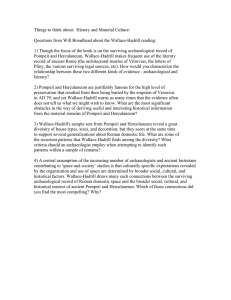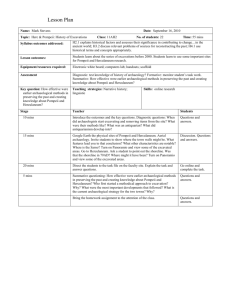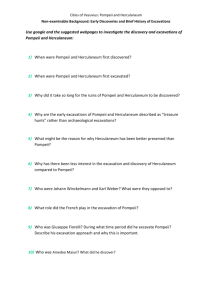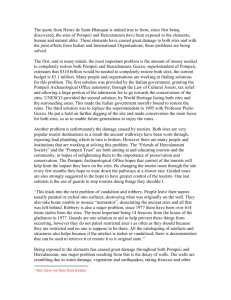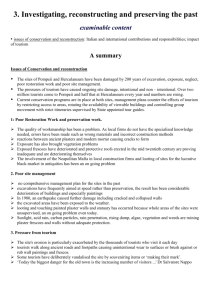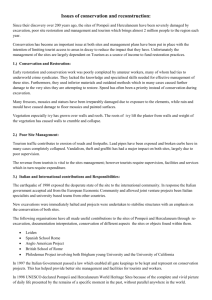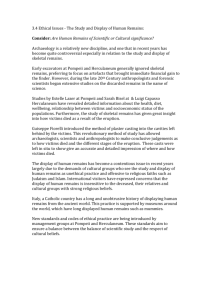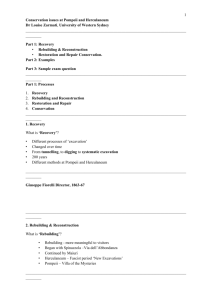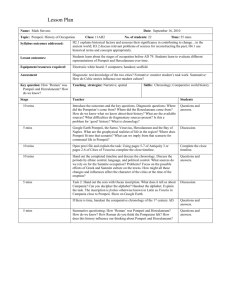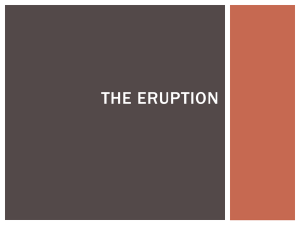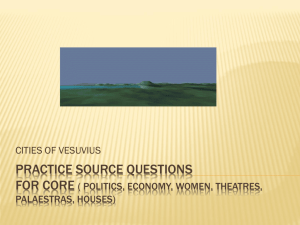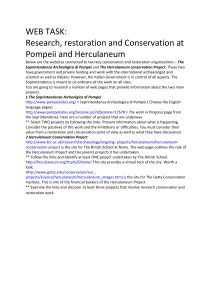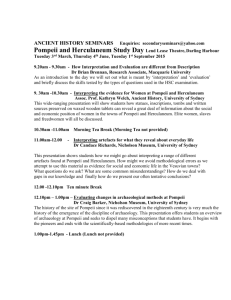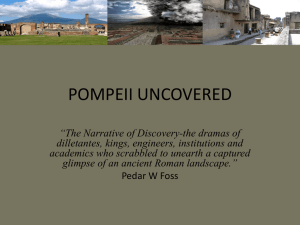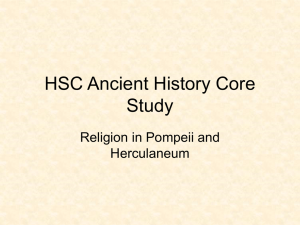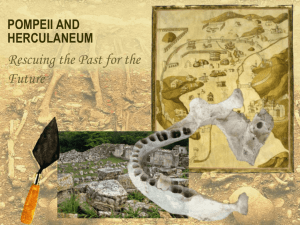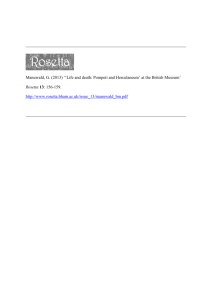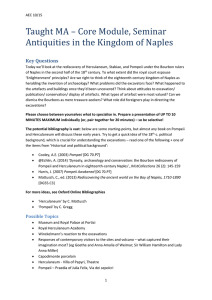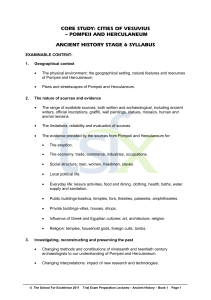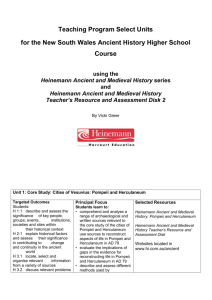Conservation Essay
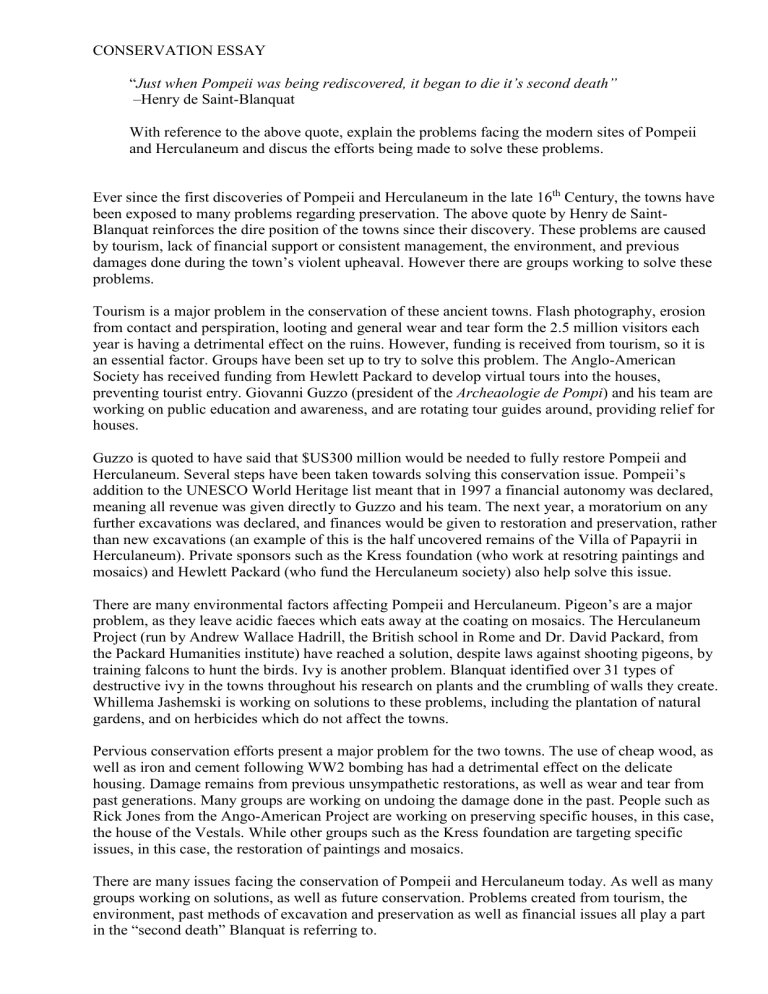
CONSERVATION ESSAY
“ Just when Pompeii was being rediscovered, it began to die it’s second death”
–Henry de Saint-Blanquat
With reference to the above quote, explain the problems facing the modern sites of Pompeii and Herculaneum and discus the efforts being made to solve these problems.
Ever since the first discoveries of Pompeii and Herculaneum in the late 16 th
Century, the towns have been exposed to many problems regarding preservation. The above quote by Henry de Saint-
Blanquat reinforces the dire position of the towns since their discovery. These problems are caused by tourism, lack of financial support or consistent management, the environment, and previous damages done during the town’s violent upheaval. However there are groups working to solve these problems.
Tourism is a major problem in the conservation of these ancient towns. Flash photography, erosion from contact and perspiration, looting and general wear and tear form the 2.5 million visitors each year is having a detrimental effect on the ruins. However, funding is received from tourism, so it is an essential factor. Groups have been set up to try to solve this problem. The Anglo-American
Society has received funding from Hewlett Packard to develop virtual tours into the houses, preventing tourist entry. Giovanni Guzzo (president of the Archeaologie de Pompi ) and his team are working on public education and awareness, and are rotating tour guides around, providing relief for houses.
Guzzo is quoted to have said that $US300 million would be needed to fully restore Pompeii and
Herculaneum. Several steps have been taken towards solving this conservation issue. Pompeii’s addition to the UNESCO World Heritage list meant that in 1997 a financial autonomy was declared, meaning all revenue was given directly to Guzzo and his team. The next year, a moratorium on any further excavations was declared, and finances would be given to restoration and preservation, rather than new excavations (an example of this is the half uncovered remains of the Villa of Papayrii in
Herculaneum). Private sponsors such as the Kress foundation (who work at resotring paintings and mosaics) and Hewlett Packard (who fund the Herculaneum society) also help solve this issue.
There are many environmental factors affecting Pompeii and Herculaneum. Pigeon’s are a major problem, as they leave acidic faeces which eats away at the coating on mosaics. The Herculaneum
Project (run by Andrew Wallace Hadrill, the British school in Rome and Dr. David Packard, from the Packard Humanities institute) have reached a solution, despite laws against shooting pigeons, by training falcons to hunt the birds. Ivy is another problem. Blanquat identified over 31 types of destructive ivy in the towns throughout his research on plants and the crumbling of walls they create.
Whillema Jashemski is working on solutions to these problems, including the plantation of natural gardens, and on herbicides which do not affect the towns.
Pervious conservation efforts present a major problem for the two towns. The use of cheap wood, as well as iron and cement following WW2 bombing has had a detrimental effect on the delicate housing. Damage remains from previous unsympathetic restorations, as well as wear and tear from past generations. Many groups are working on undoing the damage done in the past. People such as
Rick Jones from the Ango-American Project are working on preserving specific houses, in this case, the house of the Vestals. While other groups such as the Kress foundation are targeting specific issues, in this case, the restoration of paintings and mosaics.
There are many issues facing the conservation of Pompeii and Herculaneum today. As well as many groups working on solutions, as well as future conservation. Problems created from tourism, the environment, past methods of excavation and preservation as well as financial issues all play a part in the “second death” Blanquat is referring to.
